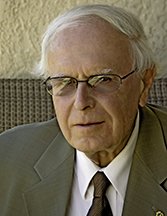Seminars
Prof. Zdeněk P. Bažant
Department of Civil and Environmental Engineering
Northwestern University
Leapfrog in Fracture and Damage Mechanics Inspired by Gap Test and Curvature-Resisting Sprain Energy

ABSTRACT: For sixty-one years after Ray Clough’s epoch-making finite element (FE) analysis of cracks in Norfolk Dam [1], there has been no completely satisfactory computational model for fracture and continuum damage. This is evidenced by recent model comparisons with many distinctive fracture tests [2], which include the size effect, shear fracture, and the new gap test [5,6]. Our studies based on these distinctive fracture tests showed limitations of different models, including phase-field models, peridynamics, and nonlocal models of integral and gradient types, while demonstrating good performance of the crack band model (CBM) with microplane M7 constitutive damage law [3,4]. As opposed to other models, the CBM has non-problematic boundary and crack-face conditions. The CBM performance can be further enhanced by introducing an energy, named the sprain energy Φ, which augments the strain energy Ψ and characterizes material resistance to the second gradient tensor of curvature of the displacement vector field, named the sprain tensor. This tensor differs from the strain gradient tensor and, importantly, includes the gradient of material rotation tensor. In FE discretization, the derivatives of Φ yield self-equilibrated sets of nodal or body sprain forces opposing excessive localization of softening damage. Subdividing the material characteristic length into a number of finite elements allows resolving the homogenized (or smooth) strain distribution across the width of the FE crack band. This leads to the smooth Crack Band Model [7] (sCBM) which, along with M7, is found to capture the big effect of crack parallel stresses on both the fracture energy and the crack front width, as evidenced by the gap test [5,6]. This presentation will provide an overview of the CBM and sCBM and demonstrate their performance with examples of FE fits using the distinctive fracture tests [2].
REFERENCES:
- Ray W. Clough (1962). The stress distribution in Norfolk Dam. Structures and Materials Series 100, IER Issue 19, Dept. of Civil Eng., Univ. of California Berkeley (134 pp.) (contract DA-03-050-Civeng-62-511, U.S. Army Engineer District, Little Rock).
- Bažant, Z.P., and Nguyen, H.T. (2023), “Proposal of a model index, MI, for experimental comparison of fracture and damage models.” J. of Engrg. Mechanics -ASCE; in press.
- Bažant, Z.P., Nguyen, H.T., and Dönmez, A.A. (2022), “Critical comparison of phase-field, peridynamics, and crack band model M7 in light of gap test and classical fracture tests.” J. of Appl. Mech. 89(6): 061008.
- Bažant, Z.P., Le, J.L., and Salviato, M. (2021), “Quasibrittle Fracture Mechanics and Size Effect: A First Course” Oxford UP.
- Nguyen, H.T., Pathirage, M., Cusatis, G., and Bažant, Z.P. (2020), “Gap test of crack-parallel stress effect on quasibrittle fracture and its consequences.” ASME J. of Applied Mechanics 87(7): 071012.
- Nguyen, H.T., Dönmez, A.A., and Bažant, Z.P. (2021), “Structural strength scaling law for fracture of plastic-hardening metals and testing of fracture properties.” Extreme Mechanics Letters 43: 101141.
- Zhang, Y., and Bažant, Z.P (2023), “Smooth crack band model—A computational paragon based on unorthodox continuum homogenization.” J. Appl. Mech. 90(4): 041007.
BIOGRAPHY: Born and educated in Prague (Ph.D. 1963), Bažant joined Northwestern University in 1969, became Professor in 1973, and served as Director of Center for Concrete Geomaterials (1981-87). Since 1990 he has been W.P. Murphy Professor of Civil and Mechanical Eng. and Materials Science, and since 2002 concurrently McCormick Institute Professor. He was inducted to the US National Academy of Sciences, US National Academy of Engrg., Am. Acad. of Arts & Sciences, Royal Society London, Austrian Academy of Sciences, Eng. Academy of Japan, Italian National Academy (dei Lincei), Spanish Royal Acad. of Engrg., Istituto Lombardo (Milan), Acad. of Engrg. of Czech Rep., Acad. of Athens, Indian Nat. Acad. of Engrg. and Academia Europaea (London). He was editor-in-chief of ASCE J. of Engrg. Mechanics, and is Regional Editor of Int. J. of Fracture; was president of Soc. of Engrg. Science, founding president of IA-FRAMCOS and of IA-CONCREEP; Division Director in IA-SMiRT; member of US Nat. Comm. on Theor. & Appl. Mech.; and chaired many committees in ASCE, RILEM, ACI, SES and IA-SMiRT. He is an Illinois Registered Struct. Engineer. In 2015, ASCE created ZP Bažant Medal for Failure and Damage Prevention. In Czech Rep. there is Bažant Prize for Enrg. Mech. His honors: Austrian Cross of Honor for Science and Art I. Class, from Austrian President, 2016; 8 honorary doctorates–CTU Prague, UC Boulder, Politecnico di Milano, TU Karlsruhe, INSA Lyon, TU Vienna, Ohio State Univ., Univ. of Minnesota; Honorary Member of ASME, ASCE, ACI and RILEM; SES Prager Medal; ASME Medal, ASME Timoshenko Medal, Warner Medal and Nadai Medal; ASCE von Karman Medal; ASCE Freudenthal Medal, Newmark Medal, Biot Medal, Mindlin Medal, Croes Medal, Huber Prize, Lifetime Achievement and TY Lin awards; Outstanding Research Award from ACS (Am. Soc. for Composites); Exner Medal (Austria), Torroja Medal (Spain); RILEM L’Hermite Medal; Solın and Bažant Sr. & Stodola Medals (Czechia, Slovakia); IACMAG Outstanding Contrib. Award; ICOSSAR Lecture Award; 2 SEAOI Meritorious Paper Awards; Best Engrg. Eng. Book of the Year (SAP); Medal of Czech Soc. for Mech.; Guggenheim, NATO, Ford, Humboldt, JSPS & Kajima Fellowships. National Winner of 1955 Math. Olympics of Czechoslovakia; Honored by Special Issues of Int. J. of Solids & Structures and Int. J. of Fracture, and by 60th, 70th, 75th and 80th birthday workshops & proc. He authored 9 books (on concrete creep, hygrothermal effects, scaling of structural strength, inelastic analysis, fracture and size effect, quasibrittle probabilistic mechanics, stability of structures, concrete at high temperature, quasibrittle fracture). In 2019 Stanford Univ. weighted citation survey* of 250,000 engineering authors, he was ranked worldwide no.1 in CE and no.2 in engineering of all fields, and in a similar survey by Elsevier in 2022 again no. 1 in CE. H-index: 147, citations: 90,000, i10 index: 677 (on Google 112022, incl. self-cit.). His 1959 mass-produced patent of safety ski binding is exhibited in New England Ski Museum, Franconia, NH.
Home: http://cee.northwestern.edu/people/bazant/
∗ https://www.mccormick.northwestern.edu/civil-environmental/news-events/news/articles/2018/bazant-ranking.html